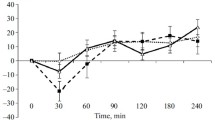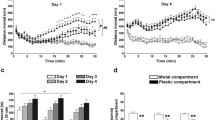Abstract
The possible role of brain histamine in the mechanisms of morphine tolerance and physical dependence is under investigation in mice.l-histidine and histamine, given during the ‘withdrawal’ phase, significantly increase tolerance to the analgesic effects of morphine but reduce the degree of physical dependence. Metiamide significantly inhibits tolerance but has no consistent effect on physical dependence. These results suggest that H2 receptors may be involved in the development of morphine tolerance. Mepyramine does not significantly affect tolerance, and with regard to dependence there is an effect only on body weight loss, which is increased. However, combined treatment with metiamide and mepyramine inhibits tolerance significantly more than metiamide alone; and withdrawal jumping is also reduced more significantly by combined treatment than by the separate administration of these drugs. It is suggested that brain histamine is definitely implicated in the mechanisms of the ‘withdrawal’ phase of morphine tolerance and physical dependence in mice, with H2 receptors probably playing the more important part.
Similar content being viewed by others
References
K. Hano, H. Kaneto, T. Kanunaga andN. Moribayashi,Pharmacological Studies of Analgesics VI: The Administration of Morphine and Changes in Acetylcholine Metabolism in Mouse Brain, Biochem. Pharmac.13, 441–447 (1964).
B.D. Gorlitz andH.H. Frey,Central Monoamines and Antinociceptive Drug Action, Eur. J. Pharmac.20, 171–180 (1972).
L. Mudgill, A.J. Friedhoff andJ. Tobey,Effect of Intraventricular Administration of Epinephrine, Norepinephrine, Dopamine, Acetylcholine and Physostigmine on Morphine Analgesia in Mice, Arch. int. Pharmacodyn.210, 85–91 (1974).
J.P. Green,Histamine and the Nervous System, Fed. Proc.23, 1095–1102 (1964).
J.W. Black, W.A.M. Duncan, C.J. Durant, C.R. Ganellin andE.M. Parsons,Definition and Antagonism of Histamine H 2 Receptors, Nature236, 385–390 (1972).
S.R. Nahorski, K.J. Rogers andB.M. Smith,Histamine H 2 Receptors and Cyclic AMP in Brain, Life Sci.15, 1887–1894 (1974).
M. Baudry, M.P. Martres andJ.C. Schwartz,H 1 and H 2 Receptors in the Histamine-Induced Accumulation of Cyclic AMP in Guinea-Pig Brain Slices, Nature253, 362–364 (1975).
H.O.J. Collier, D.L. Francis andC. Schneider,Modification of Morphine Withdrawal by Drugs Interacting with Humoral Mechanisms: Some Contradictions and their Interpretation, Nature237, 220–223 (1972).
L. Grumbach, M. Shelofsky andJ.E. Boston, Jr.,The Kinetics of Physical Dependence to Morphine in the Rat, Pharmac.11, 38–51 (1974).
F. Frumkin,Physical Dependence in Rats after Low Morphine Doses, Life Sci.15, 455–462 (1974).
K.S. Hui andM.B. Roberts,An Improved Implantation Pellet for the Rapid Induction of Morphine Dependence in Mice, J. Pharm. Pharmac.27, 569–573 (1975).
F.E. D'Amour andD.L. Smith,Method for Determining Loss of Pain Sensation, J. Pharmac. exp. Ther.72, 74–79 (1941).
C. Kameii andS. Ueki,Naloxone-Induced Abstinence Syndromes in Morphine-Treated Mice, Jap. J. Pharmac.24, 655–657 (1974).
I. Marshall andM. Weinstock,A Quantitative Method for the Assessment of Physical Dependence on Narcotic Analgesics in Mice, Br. J. Pharmac.37, 505–506P (1969).
D.L. Francis andC. Schneider,Jumping after Naloxone Precipitated Withdrawal of Chronic Morphine in the Rat, Br. J. Pharmac.41, 424–425P (1971).
E.L. Way, H.H. Loh andF.H. Shen,Simultaneous Quantitative Assessment of Morphine Tolerance and Physical Dependence, J. Pharmac. exp. Ther.167, 1–8 (1969).
E. Wei, H.H. Loh andE.L. Way,Quantitative Aspects of Precipitated Abstinence in Morphine Dependent Rats, J. Pharmac. exp. Ther.148, 399–403 (1973).
K.M. Taylor andS.H. Snyder,Dynamics of the Regulation of Histamine Levels in Mouse Brain, J. Neurochem.19, 341–354 (1972).
K.S. Hui andM.B. Roberts,L-Histidine: Effect on the Development of Morphine Dependence in Mice, IRCS2, 1688 (1974).
Author information
Authors and Affiliations
Rights and permissions
About this article
Cite this article
Wong, CL., Roberts, M.B. The possible role of brain histamine and H1 and H2 receptors in the development of morphine tolerance and physical dependence in mice. Agents and Actions 5, 476–483 (1975). https://doi.org/10.1007/BF01972684
Received:
Accepted:
Issue Date:
DOI: https://doi.org/10.1007/BF01972684




